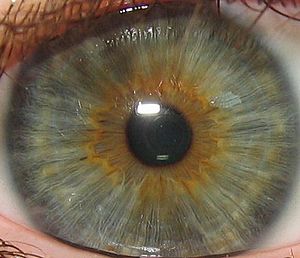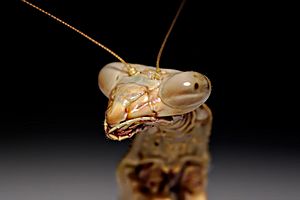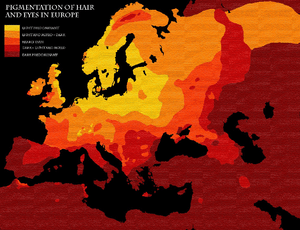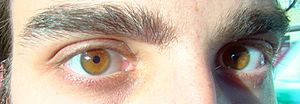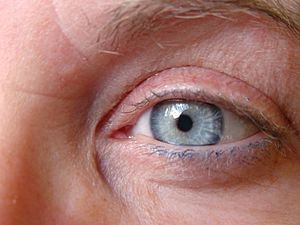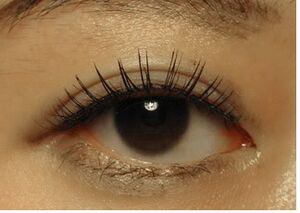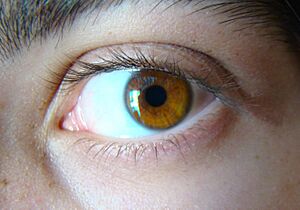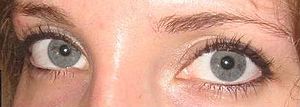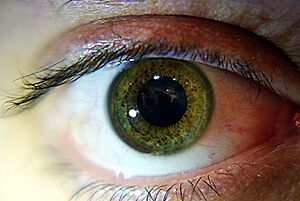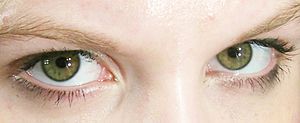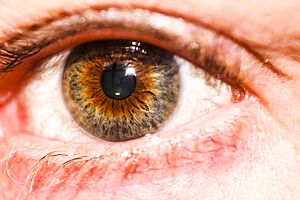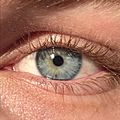Eye colour facts for kids
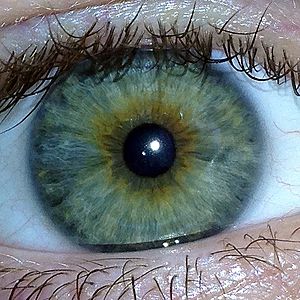


Eye color is how your eyes look, like blue, brown, or green. It's decided by two main things: the amount of a special coloring called melanin in the iris (the colored part of your eye), and how light bounces off the iris.
Contents
What Makes Eye Color?
In people, the color of the iris can be anything from light brown to black. This depends on how much melanin is in the iris. Melanin is a natural pigment that gives color to your skin, hair, and eyes.
For colors like blue, green, and hazel, it's also about how light scatters when it hits the top layer of the iris. This is called Rayleigh scattering. It's the same reason why the sky looks blue! Blue and green colors don't come from actual blue or green pigments in your eyes. Instead, they are "structural colors," meaning they change a bit depending on the light.
Many animals like birds, reptiles, and insects have very bright eye colors. These colors come from different pigments than melanin, such as pteridines or carotenoids.
How Eye Color is Passed Down
Eye color is mostly decided by your genes. It's not as simple as one gene for one color. Two main genes, called OCA2 and HERC2, are very important for eye color. They are found close together on chromosome 15. Small changes in these genes can cause many different eye colors.
There are also about 15 other genes that can affect eye color. This is called epistasis, where many genes work together to create a trait.
Different Eye Colors
Scientists have created charts to describe eye colors. One well-known chart is the Martin scale. It helps classify eyes from very light to very dark.
Amber Eyes
Amber eyes are a solid color, often looking yellowish, golden, or coppery. This color might come from a yellow pigment called lipochrome in the iris.
Amber eyes are different from hazel eyes. While hazel eyes can have specks of amber or gold, they usually have many other colors like green, brown, and orange. Hazel eyes might also seem to change color and have flecks, but amber eyes are a more solid golden color.
Many animals, like dogs, cats, owls, and eagles, often have amber eyes. It's less common in humans.
Blue Eyes
Blue eyes don't have blue pigment. The dark layer at the back of the iris absorbs longer light waves. Shorter light waves are reflected and scatter in the front part of the iris, making the eyes look blue. This is the same way the sky looks blue!
Scientists believe that all blue-eyed people might share a single common ancestor. This is because they have a very similar DNA sequence in the region of the OCA2 gene. A tiny change in the HERC2 gene is thought to reduce how much melanin is made, leading to blue eyes.
| Blue-eyed populations | ||||
|---|---|---|---|---|
| Country | Percent of population | |||
| Finland | 89% | |||
| Estonia | 89% | |||
| Ireland | 57% | |||
| Scotland | 50% | |||
| England | 48% | |||
| Wales | 45% | |||
| Belgium (adult population) | 28.9% | |||
| France (adult pop.) | 20.2% | |||
| United States | 16.6% | |||
| Spain | 16.3% | |||
| Algeria (adult pop.) | 2.6% | |||
| Morocco (adult pop.) | 2.1% | |||
| Tunisia (adult pop.) | 1.2% | |||
| sources: | ||||
Blue eyes are very common in northern and eastern Europe, especially near the Baltic Sea. They can also be found in other parts of the world, like Central and South Asia, and parts of North and West Africa.
Blue eyes are rare in most mammals. Some cats and dogs have blue eyes, but this can sometimes be linked to other traits like deafness. However, there are different genetic reasons for blue eyes in animals.
Brown Eyes
Brown eyes have a lot of melanin in the iris. This melanin absorbs most of the light, making the eyes look brown.
Dark brown eyes are the most common eye color in humans around the world. They are very common in places like Asia, Africa, and the Americas, as well as parts of Europe. Lighter or medium brown eyes are also common in Southern Europe, the Americas, and parts of Central Asia.
Gray Eyes
Like blue eyes, gray eyes have a dark layer at the back of the iris. The front part of the iris is quite clear. One idea is that gray eyes have more collagen in the front part of the iris. This causes light to scatter in a way that makes the eyes look gray, similar to how clouds look gray.
Gray eyes are most common in Northern and Eastern Europe. They can also be found in some parts of North Africa, the Middle East, and South Asia. If you look closely at gray eyes, you might see small amounts of yellow and brown color in the iris.
Green Eyes
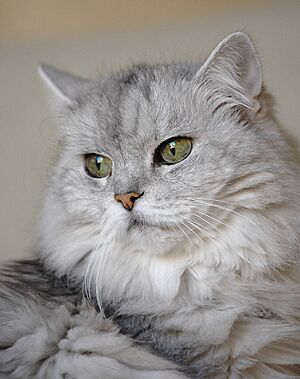
Green eyes are also a mix of colors, not just green pigment. They happen when there's a small to medium amount of melanin in the iris, combined with a yellowish pigment called lipochrome. When light scatters in these eyes, it creates a blue shade. This blue shade mixes with the yellowish pigment to make green.
Green eyes are most common in Northern, Western, and Central Europe. In countries like Ireland and Scotland, most people have either blue or green eyes. Green eyes are also common in some types of cats, like Tabby cats and Chinchilla Persian cats.
Hazel Eyes
Hazel eyes are a mix of colors, often appearing to shift between brown and green. They are caused by a combination of light scattering and a moderate amount of melanin in the iris.
Hazel eyes can have brown, gold, or green as the main color. This is why they are sometimes confused with amber eyes. When seen in sunlight, hazel eyes can look multicolored, like light brown or amber near the pupil and dark green on the outer part.
Hazel eyes are common in people with European backgrounds, especially where people with blue, green, and brown eyes have mixed.
Red and Violet Eyes
People with severe albinism (a condition where the body makes very little or no melanin) might have eyes that look red in certain lights. This happens because there's so little melanin that the blood vessels in the eye show through.
Sometimes, in photos taken with a flash, people's eyes can look red. This is called the "red-eye effect" and happens when the bright flash reflects off the blood-rich retina at the back of the eye.
While some deep blue eyes can look violet sometimes, truly violet-colored eyes are usually only seen in people with albinism.
Images for kids
-
Actor Daniel Craig with blue eyes.
-
Sclater's lemur, also known as the blue-eyed black lemur.
See also
 In Spanish: Color de ojos para niños
In Spanish: Color de ojos para niños


